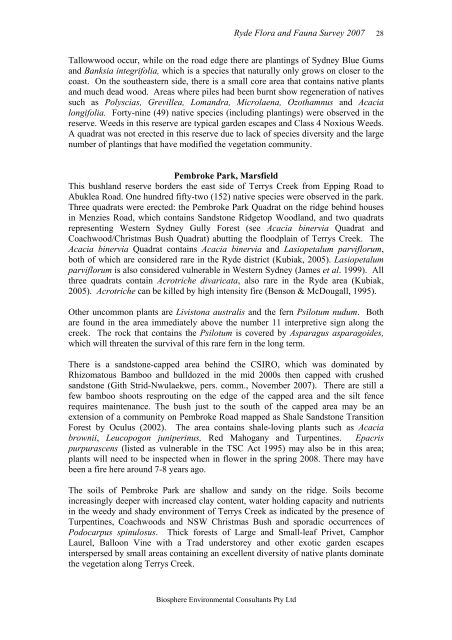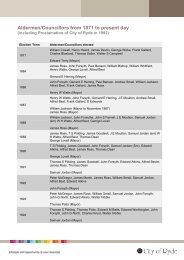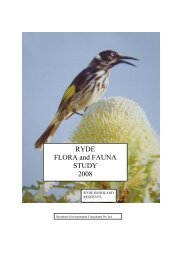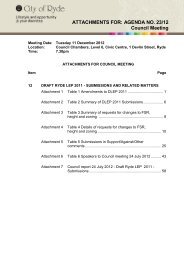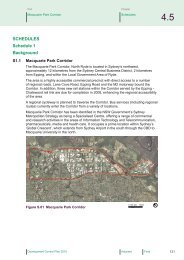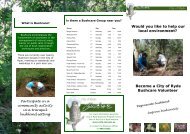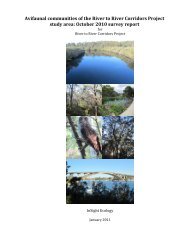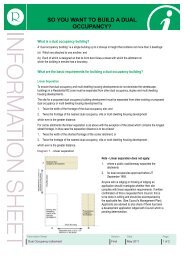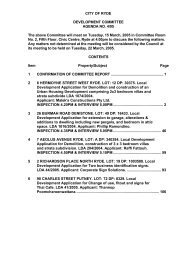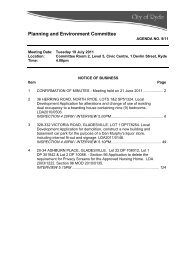RYDE FLORA and FAUNA STUDY 2007 - City of Ryde - NSW ...
RYDE FLORA and FAUNA STUDY 2007 - City of Ryde - NSW ...
RYDE FLORA and FAUNA STUDY 2007 - City of Ryde - NSW ...
You also want an ePaper? Increase the reach of your titles
YUMPU automatically turns print PDFs into web optimized ePapers that Google loves.
Biosphere Environmental Consultants Pty Ltd<br />
<strong>Ryde</strong> Flora <strong>and</strong> Fauna Survey <strong>2007</strong> 28<br />
Tallowwood occur, while on the road edge there are plantings <strong>of</strong> Sydney Blue Gums<br />
<strong>and</strong> Banksia integrifolia, which is a species that naturally only grows on closer to the<br />
coast. On the southeastern side, there is a small core area that contains native plants<br />
<strong>and</strong> much dead wood. Areas where piles had been burnt show regeneration <strong>of</strong> natives<br />
such as Polyscias, Grevillea, Lom<strong>and</strong>ra, Microlaena, Ozothamnus <strong>and</strong> Acacia<br />
longifolia. Forty-nine (49) native species (including plantings) were observed in the<br />
reserve. Weeds in this reserve are typical garden escapes <strong>and</strong> Class 4 Noxious Weeds.<br />
A quadrat was not erected in this reserve due to lack <strong>of</strong> species diversity <strong>and</strong> the large<br />
number <strong>of</strong> plantings that have modified the vegetation community.<br />
Pembroke Park, Marsfield<br />
This bushl<strong>and</strong> reserve borders the east side <strong>of</strong> Terrys Creek from Epping Road to<br />
Abuklea Road. One hundred fifty-two (152) native species were observed in the park.<br />
Three quadrats were erected: the Pembroke Park Quadrat on the ridge behind houses<br />
in Menzies Road, which contains S<strong>and</strong>stone Ridgetop Woodl<strong>and</strong>, <strong>and</strong> two quadrats<br />
representing Western Sydney Gully Forest (see Acacia binervia Quadrat <strong>and</strong><br />
Coachwood/Christmas Bush Quadrat) abutting the floodplain <strong>of</strong> Terrys Creek. The<br />
Acacia binervia Quadrat contains Acacia binervia <strong>and</strong> Lasiopetalum parviflorum,<br />
both <strong>of</strong> which are considered rare in the <strong>Ryde</strong> district (Kubiak, 2005). Lasiopetalum<br />
parviflorum is also considered vulnerable in Western Sydney (James et al. 1999). All<br />
three quadrats contain Acrotriche divaricata, also rare in the <strong>Ryde</strong> area (Kubiak,<br />
2005). Acrotriche can be killed by high intensity fire (Benson & McDougall, 1995).<br />
Other uncommon plants are Livistona australis <strong>and</strong> the fern Psilotum nudum. Both<br />
are found in the area immediately above the number 11 interpretive sign along the<br />
creek. The rock that contains the Psilotum is covered by Asparagus asparagoides,<br />
which will threaten the survival <strong>of</strong> this rare fern in the long term.<br />
There is a s<strong>and</strong>stone-capped area behind the CSIRO, which was dominated by<br />
Rhizomatous Bamboo <strong>and</strong> bulldozed in the mid 2000s then capped with crushed<br />
s<strong>and</strong>stone (Gith Strid-Nwulaekwe, pers. comm., November <strong>2007</strong>). There are still a<br />
few bamboo shoots resprouting on the edge <strong>of</strong> the capped area <strong>and</strong> the silt fence<br />
requires maintenance. The bush just to the south <strong>of</strong> the capped area may be an<br />
extension <strong>of</strong> a community on Pembroke Road mapped as Shale S<strong>and</strong>stone Transition<br />
Forest by Oculus (2002). The area contains shale-loving plants such as Acacia<br />
brownii, Leucopogon juniperinus, Red Mahogany <strong>and</strong> Turpentines. Epacris<br />
purpurascens (listed as vulnerable in the TSC Act 1995) may also be in this area;<br />
plants will need to be inspected when in flower in the spring 2008. There may have<br />
been a fire here around 7-8 years ago.<br />
The soils <strong>of</strong> Pembroke Park are shallow <strong>and</strong> s<strong>and</strong>y on the ridge. Soils become<br />
increasingly deeper with increased clay content, water holding capacity <strong>and</strong> nutrients<br />
in the weedy <strong>and</strong> shady environment <strong>of</strong> Terrys Creek as indicated by the presence <strong>of</strong><br />
Turpentines, Coachwoods <strong>and</strong> <strong>NSW</strong> Christmas Bush <strong>and</strong> sporadic occurrences <strong>of</strong><br />
Podocarpus spinulosus. Thick forests <strong>of</strong> Large <strong>and</strong> Small-leaf Privet, Camphor<br />
Laurel, Balloon Vine with a Trad understorey <strong>and</strong> other exotic garden escapes<br />
interspersed by small areas containing an excellent diversity <strong>of</strong> native plants dominate<br />
the vegetation along Terrys Creek.


